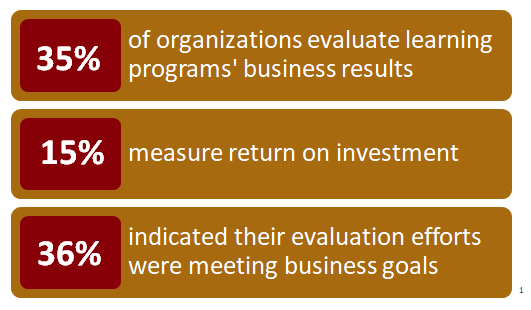|
Ask nearly any Learning and Development (L&D) professional about his/her efforts to evaluate training and the responses can be described as dismal, at best. L&D and organizational leaders alike recognize the value in collecting data to determine whether learning supports business results. Who hasn’t heard a leader ask for the business impact of learning? Yet organizations’ L&D often faces barriers that prevent them from delivering data-driven results. Association for Talent Development’s (ATD’s) 2016 research report, Evaluating Learning: Getting to Measurements, surveyed 199 talent development professionals and found that only: There’s room for improvement. So, what gets in the way? The same report asked participants a similar question. Identifying and Overcoming Barriers Participants reported challenges isolating the impact of learning on results and a lack of:
These barriers may be of no surprise. Still, what simple steps can an organization take to overcome them? Let’s look at each barrier and lay out some tips to address them. Access Critical Data
LMS Functionality Make your product work for you! Once you identify what you want to measure, connect with your provider to discuss solutions. If the LMS has limited capabilities, what technology and systems exist in-house to help you achieve your goal? For example, is there an existing dashboard that could capture required information? Rethink current analytic processes and brainstorm on expanding functionality. Resources Evaluation is as much of a mindset as it is a strategy. Develop a two-pronged approach that aligns with the Kirkpatrick-Phillips model and apply that strategy at the onset of every project discovery discussion and beyond. Yes, data collection often poses challenges, but don’t overthink it. Look for ways to simplify it. You don’t want or need ROI for every course or effort. Consider some of the examples below, or use them to spark ideas for other methods to evaluate learning opportunities:
Achieving Results Maximizing resources, improving business impact, and creating value for learners are some of the outcomes an organization can achieve when evaluation obstacles are removed. It starts by creating an evaluation mindset, commitment, and culture. An organization’s efforts don’t have to be costly or time-consuming to accomplish evaluation goals that link to business outcomes. Developing an evaluation strategy can guide and automate efforts and set an organization on the right path. Stay tuned for an upcoming blog post where we introduce Net Promoter Scores (NPSs) as an evaluation tool. [1] Ho, M. (2016, April 07). Evaluating the Business Impact of Learning: Why Aren't More Organizations Doing It? Retrieved November 15, 2017, from https://www.td.org/Publications/Blogs/L-and-D-Blog/2016/04/Evaluating-the-Business-Impact-of-Learning
0 Comments
|
Archives
August 2020
BlogOur clients and the training community ask us questions and often consistent themes emerge. From making learning stick to developing skills we once assumed every employee possessed, the challenges today’s businesses face can be transformed through a strong learning culture.
Every year, the learning and development industry presents exciting developments, time-saving innovations, and new research. Solutions Arts follows and tests theories, practices, and technologies, and our clients benefit from what we learn. We value sharing what we learn and the opportunity to discuss it here on our blog.
Categories |


 RSS Feed
RSS Feed